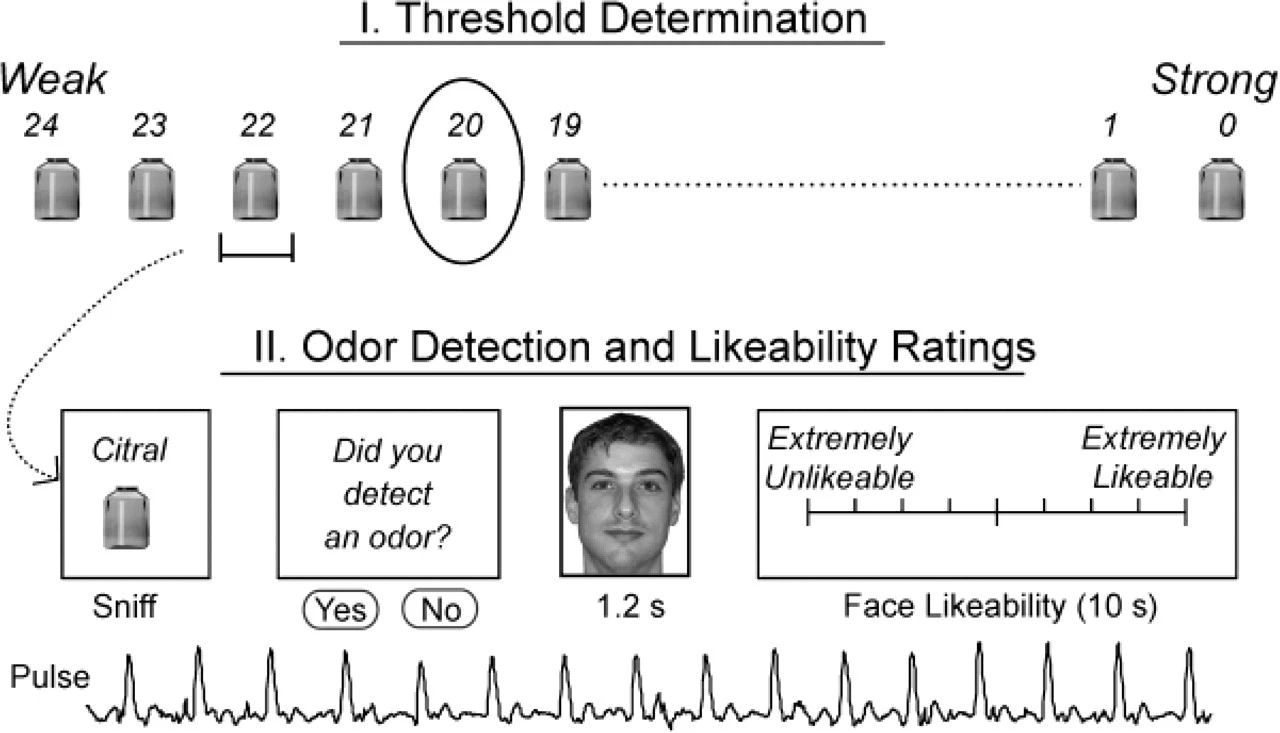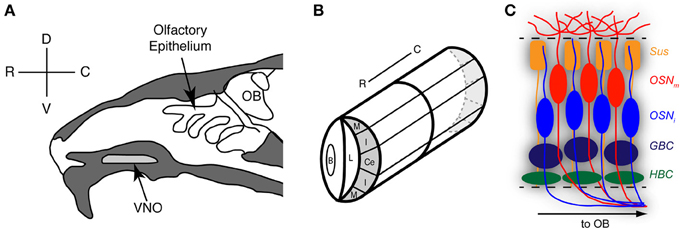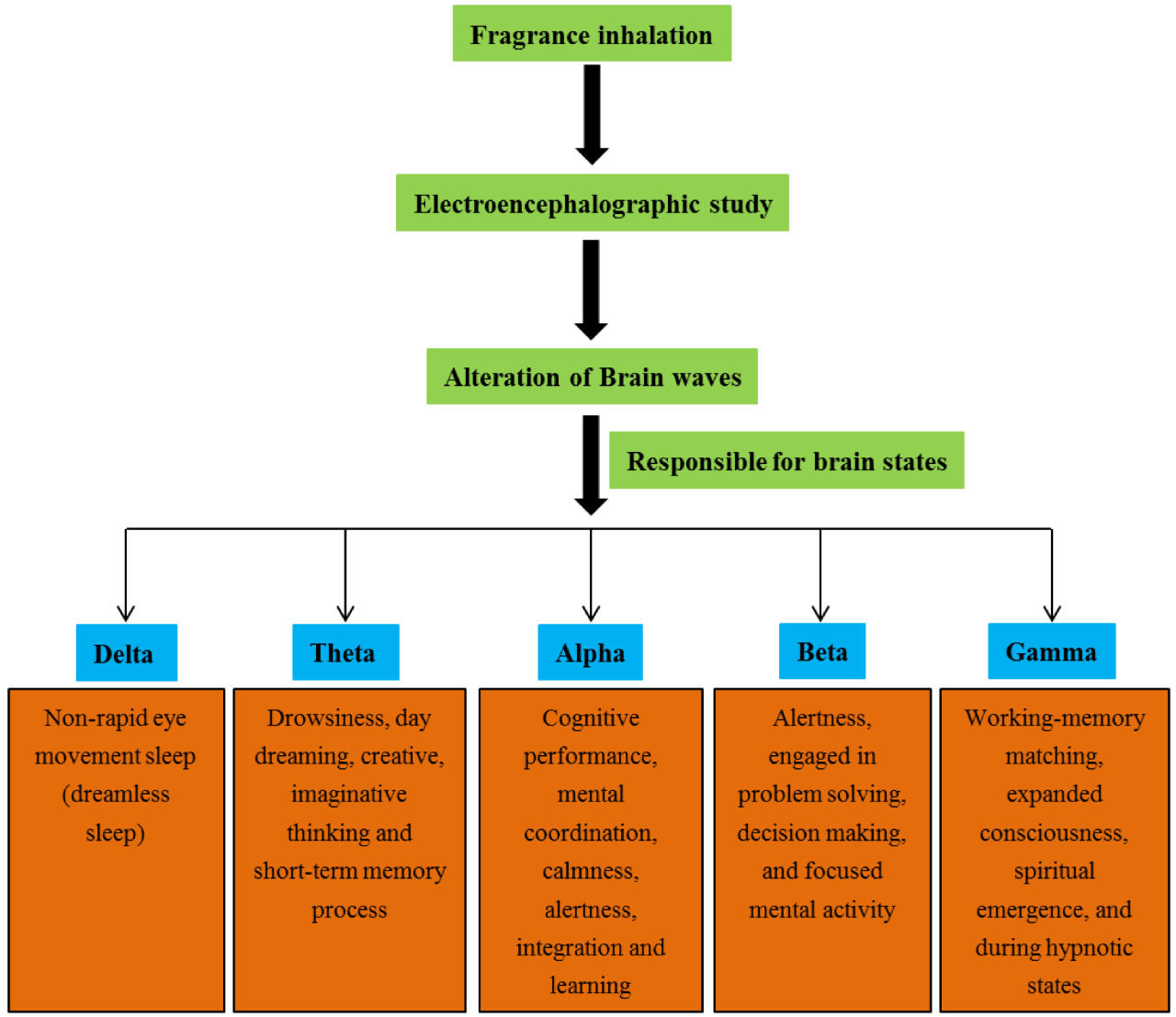服務熱線
177-5061-9273


為什么大型香水公司要建立EEG部門?香味能喚起記憶、思想和感情,而嗅覺是一門復雜的科學。
在紐約、圣保羅、巴黎和新加坡(僅舉幾例)的高層建筑中,你可以找到現代香水行業的實驗室和辦公室。
這就是那些精通香水藝術(和科學)的人,將有趣的氣味分子混合在一起,最終形成微小的香油滴,不僅可以進入你梳妝臺上的一瓶香水或須后水,還可以進入你的洗衣液、沐浴露、洗碗皂、止汗劑……。
下次你洗澡或淋浴時,看看肥皂或洗發水的瓶子。在配料表中,你通常能找到“香料fragrance”這個詞。
但這個詞并不能公平地描述隱藏在這9個字母背后的數十億美元的產業。如果我告訴你這些公司有腦電圖部門。是的,腦電圖。
也許你會問,究竟為什么像高砂、德之馨和奇華頓這樣的香水公司要使用EEG?
對香味的感知
氣味就像圖像或音樂一樣,能夠喚起記憶,影響你的想法和感覺。事實上,這甚至已經發展成為一個完整的芳香療法領域,旨在治愈你的壓力,改善你的情緒(參見Rachel Herz的綜述https://www.tandfonline.com/doi/full/10.1080/00207450802333953)。

氣味好還不夠。現在,人們期望香水能提升情緒、平靜情緒,甚至能提高注意力——人們很快就把這些功能和其他功能結合起來了。“我們擁有的數據顯示,80%的消費者正在尋找一種改善他們健康的方法,而他們通常在他們使用的品牌中找不到這種方法……
更重要的是,氣味通常是在潛意識層面上起作用的,你甚至都沒有注意到——看看西北大學研究人員的這項研究(https://journals.sagepub.com/doi/full/10.1111/j.1467-9280.2007.02023.x)吧。

實驗范式。首先,使用上升樓梯程序確定參與者特定的氣味檢測閾值。然后,參與者完成一項氣味檢測和喜好判斷任務。在本例中,檢測閾值為稀釋20,因此在主要任務中使用稀釋22。在這項任務中,參與者嗅了一個瓶子,指出它是否含有氣味,觀看了一個面部刺激,最后評價了這張臉的受歡迎程度。對于一部分參與者,記錄了心率。
然而,我們對氣味的感知反應并不像對視覺或聽覺刺激那么直接。
當你聞到一種由100多種不同成分混合而成的香水時,你只需要考慮它的化學動力學就能意識到它有多復雜。不同的分子以不同的速度到達你的鼻子。知覺體驗隨著每一次呼吸、每一次嗅聞而變化。香味會隨著時間的推移而變化,所以你第一次使用香味產品時聞到的味道和幾小時后聞到的味道是不同的。更不用說隨著時間的推移,你會適應和習慣香味,這意味著你的鼻子和大腦都會在重復或持續接觸氣味的情況下降低對氣味的敏感度和反應。
還有一個額外的因素是,你的嗅覺在你的一生中是可塑的。你的鼻子和大腦之間的連接路徑會根據你的嗅覺體驗不斷更新。不僅在產前和童年時期,而且在你成年后,也會改變你對香味的感知方式(參見杰西卡·布蘭恩和斯圖爾特·費爾斯坦的這篇綜述https://www.frontiersin.org/articles/10.3389/fnins.2014.00182/full)。

小鼠嗅覺上皮的組織和區域。(A)嚙齒動物鼻子的矢狀圖,描繪了嗅覺上皮和犁鼻器(VNO)的位置。(B) VNO為雙側對稱管狀結構;這里顯示的是一個冠狀面的一半,因為它將通過這個結構的深度出現。邊緣區(M)位于VNO的極端背側(D)和腹側(V)區域。與邊緣帶相鄰的是中間帶(I),中間帶和中間帶之間是中心帶(Ce)。OB,嗅球;OE,嗅上皮;B,血管;C,尾;L,腔;R,吻側。《神經科學雜志》(Brann and Firestein, 2010)授權轉載。(C)嗅覺上皮由五種原始細胞類型組成,包括水平基底細胞(HBC)、球形基底細胞(GBC)、未成熟嗅覺感覺神經元(OSNi)、成熟嗅覺感覺神經元(OSNm)和支撐細胞(Sus)。
香味和腦電圖
即使對最專業的嗅覺腦電圖研究人員來說,嗅覺感知的復雜性也構成了相當大的挑戰。但是,除了使用腦電圖(EEG)之類的技術(見腦電圖測量什么?有關此技術的更多信息)。
無線腦電圖系統的進步(參見將神經技術帶出實驗室)為這些香水公司的研究部門提供了以一種經濟、快速和有意義的方式測量實時大腦反應的機會,以支持香水開發過程。這可以幫助他們理解氣味和其他感官之間的多感官相互作用;為了測量注意力投入的程度;或者研究香水的情感影響。
的確,不同的香味會在大腦活動中產生根本不同的動態反應。
韓國江原國立大學的植物研究人員sonndharajan和Kim在這里總結了EEG對不同植物香味的反應的一些不同研究結果。各種研究證明了從植物中提取的各種香精油具有喚醒(激活)或放松的特性,通常是通過分析主要的腦電圖頻段,如α和β。這些信息可以被香水公司用來指導他們的香水開發過程。(https://www.mdpi.com/2218-0532/84/4/724)

腦電波自然地出現在活動狀態和休息狀態。我們的思想、情緒和行為都是大腦中神經元活動的反映。腦電波的激活是神經元電活動的特征,特別是大腦中神經元離子流產生的電壓波動。腦電圖測量這些電活動,并將其表示為波或振蕩。通常,這些腦電波代表了整個大腦的特定功能。腦電圖可能受睡眠、腦功能障礙、藥物和年齡等因素的影響。根據大腦功能的不同狀態,有許多從0.05到500hz不等的獨立波段。當我們感到疲倦、遲鈍或做夢時,頻率較低的腦電波占主導地位。另一方面,當我們感到興奮或高度警覺時,較高的頻率占主導地位。以下頻段類別與治療最相關(圖2)。
理解個人和文化偏好
從研究的角度來看,EEG可以幫助這些全球組織的科學家揭示世界各地不同人群和文化中嗅覺反應的差異,以了解經驗、文化和個性如何導致對香味的感知和偏好的差異。這也說明了為什么有些人更喜歡果香、花香,而有些人更喜歡木質、泥土味。并展示了這種多樣性是如何在人類大腦的復雜世界中表現出來的。
當然,腦電圖不能告訴你如何創造完美的香水。這仍然是香水大師的工作,他們在世界各地的一些香水學校接受了多年的培訓。這些人的專業知識被如此珍視,以至于他們的香水配方都是最高機密,只有少數人知道。
但下次當你用有香味的肥皂洗手,或把剛洗好的衣服收起來時,停下來想一想你的腦電圖會是什么樣子。為了支持這一想法,這里有一張人們已經發現的表格(摘自桑德哈拉賈和金,2016年)
表:吸入香氣對腦電圖活動的影響
| S. No. | Odorant Materials | EEG Wave Changes | Brain Functions |
| 1. | Galaxolide | Alpha decreased. | Odors produce divided attention even when undetected. |
| 2. | m-Xylene | Alpha increased. | Stimulating and excitatory effects. |
| 3. | Birch tar, galbanum, heliotropine, jasmine, lavender, lemon and peppermint | Increased theta for birch tar, jasmine, lavender and lemon. | Subjects differed in their subjective responses to the odors. |
| 4. | 5-α-Androstan-3-one, bangalol, white sapphire, indole, linalyl acetate, eucalyptus oil and ammonia. | Alpha increased. | From more anterior electrodes—related to psychometric responses. |
| 5. | Phenylethyl alcohol and valeric acid | Valeric acid—alpha 2 increased. | Unpleasant odor leads to a cortical deactivation. |
| 6. | Lavender and rosemary | Lavender—beta increased. Rosemary—frontal alpha and beta decreased. | Lavender—increased drowsiness. Rosemary—increased alertness. |
| 7. | Synthetic odors—almond, chocolate, spearmint, strawberry, vegetable, garlic, onion and cumin Odors of real foods—chocolate, baked beans and rotting pork | Chocolate odor—less theta activity. | Reduced level of attention. |
| 8. | Chewing of marketed gum | Alpha power increased. | Arousal psychosomatic responses. |
| 9. | Valeriana off, Lavandula off, Passiflora incarnata, Piper methysticum, Melissa off, Eschscbolzia californica, Hypericum perforatum and Ginkgo biloba | Valerian extract—delta and theta activity increased and beta activity decreased. | Self-rated tiredness increased under some of the plant extracts. |
| 10. | (R)-(?)-, (S)-(+)- and (RS)-(±)-forms of linalools | (RS)-(±)-linalool—greater decrease of the beta wave after work than before work. | (RS)-(±)-linalool and (R)-(?)-linalool -favorable impression. (S)-(+)-linalool—unfavorable impression. |
| 11. | Chewing regular gum or gum base without flavor | Alpha-2 and beta-2 increased for regular gum and decreased for gum base. | Activates different brain neuronal populations. |
| 12. | Sedative effects—lemon, lavender and sandalwood Awakening effects—jasmine, ylang-ylang, rose and peppermint | Awakening fragrances—decreased alpha and beta activities. | Sedative fragrances—improvement in productivity. Awakening fragrances—effect in mitigating the workload. |
| 13. | Lavender, chamomile, sandalwood and eugenol | Alpha 1 decreased at parietal and posterior temporal regions. | Subjects felt comfortable. |
| 14. | Chewing gum with and without flavor and flavored aromatic oil | Chewing gum with flavor and inhale aromatic oil increase alpha and beta waves. | Induce concentration with a harmonious high arousal state in brain function. |
| 15. | Enantiomers of linalools | (R)-(?)-linalool—beta decreased after hearing environmental sound. Mental work—beta increased. | Odor perception and responses—chiral dependence and also with task dependence. |
| 16. | Aroma of soybeans heated to various temperatures | Alpha wave increased—heated after immersion in fructose–glycine solution. | Amino-carbonyl reaction aroma products increase brain alpha waves. |
| 17. | β-Damascenone | Non-significant trend for left frontal differences in EEG associated with different liking responses. | Left frontal response associated with liking an odor. |
| 18. | Lavender and rosemary aromas | Induce left frontal EEG shifting in adults and infants with greater baselines than right frontal EEG activation. | Associated with greater approach behavior and less depressed affect. |
| 19. | General workers, perfume salespersons and professional perfume researchers | Professional perfume researchers respond to odors mainly in the frontal region. | Functional coupling for people—occupationally exposed to odors may be related to psychological preference. |
| 20. | Lavender and rosemary | Increased relative left frontal EEG asymmetry. | Infants of depressed and non-depressed mothers respond differently to odors. |
| 21. | Para-cresol 4-methylphenol, 2-heptanone, methional 3-methylthiopropionaldehyde and dimethyltrisulphide. | Theta wave activation in frontal region between the different populations. | Cultural differences in odor responsiveness. |
| 22. | Pleasant odor | Beta wave increased in the left frontal region. | Enhancement of left frontal brain region by a pleasant odor. |
| 23. | Neroli and grapefruit oils | Slow alpha (8–10 Hz) and theta activities increased in the occipital region. | Reduce the cortical deactivation or promote a relaxed state. |
| 24. | Low-dose alcohol | Theta power decreased in both hemispheres in the high-dose condition. | Corresponding to working memory demand. |
| 25. | Odor of incense and rose oil | Fast alpha activity increased in bilateral posterior regions during incense exposure. | Cortical and function of inhibitory processing of motor response. |
| 26. | Citrus bergamia oil | Negative percentage changes of the ratio of low to high frequency in the music, aroma and combined groups than control group. | Listening to soft music and inhaling Citrus bergamia essential oil—effective method of relaxation. |
| 27. | Abies sibirica essential oil | Increased theta activity after the visual display terminal task. | Prevention of visual display terminal—mental health disturbance. |
| 28. | Lavandula angustifolia | Good sleep quality—occipital and parietal alpha decreased, frontal theta and occipital beta increased. Poor sleep quality—theta increased in the all cranial regions. | Beneficial effect for female adults with sleep disorder. |
| 29. | Lavender oil | Theta and alpha activities increased. | Relaxing effect of inhaling lavender oil. |
| 30. | Essential oil of Zizyphus jujuba seeds | Fast alpha increased in the left prefrontal, right prefrontal and left frontal regions. | Increasing attention and relaxation. |
| 31. | Essential oil of Mentha arvensis L. f. piperascens aerial parts | Relative fast alpha increased. Gamma and the spectral edge frequency 90% decreased. | Reducing mental stress. |
| 32. | Jasmine oil | Beta wave increased in the anterior center and left posterior regions. | Increased—feeling of well-being, active, fresh and romantic. |
| 33. | Ylang–ylang essential oil | Prolonged the latencies of P300 | Not affect information processing resources in patients with TLE. |
| 34. | Essential odors—mint and lemon Commerical odors—criton-verbena, lize, melody and rozan | All odors affected the EEG waves in at least some subjects. | Essential odors stimulated more than commercial odors and women are more sensitive than men. |
| 35. | Pan-fired Japanese green tea (Koushun and Kouju) | Kouju affect the beta 1 at right frontal region. | Improve memory task performance. |
| 36. | Magnolia kobus flower | Absolute alpha decreased at left parietal region. | Awaken and increase the concentration states of brain. |
| 37. | Strawberry aroma (food) and the odor of lily of the valley (non-food) | Specific scalp potential maps for the two conditions. | Food odor—associated with the processing of rewards. Non-food odor—reflects odor characteristics excluding the reward. |
| 38. | Hyperbaric oxygen exposure | Fast delta decreased and alpha increased in the posterior regions. | Oxygen-toxicity diving-related problems. |
| 39. | Lemon, peppermint, and vanilla | Theta showed statistically significant results between different odor conditions | Stimuli can affect the frequency characteristics of the electrical activity of the brain. |
| 40. | Isomers of limonene and terpinolene | (+)-Limonene—relative high beta increased in the right temporal region. Terpinolene—relative mid beta decreased and relative fast alpha increased in the right prefrontal region. | Terpinolene—reducing the tension and increasing the relaxation and stabilization states of brain function. |
| 41. | Essential oil of Inula helenium root | Theta (in all the regions except T3), beta (Fp1) and mid beta (P4) and relative theta (Fp1, Fp2, F3 and F4) decreased. | Enhance the alertness state of brain. |
| 42. | Lavender and bergamot | The absolute theta increased at the right prefrontal region Significant differences in the relative fast and slow alpha. | Both physical and mental states became more stable and relaxed. |